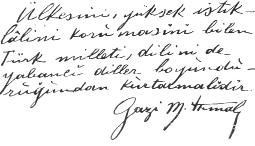History
Ottoman era
During interactions with Arabic and Persian-speaking nations, Turks adopted words not present in their own language. Alongside these absent words, however, Turkish words gradually lost their functionality over time, yielding to Arabic and Persian vocabulary. For instance, the Turkic-origin word "od" meaning "fire" gave way to the Persian-origin word "ateş". Not only words but also grammatical rules and constructions were borrowed from both languages. Nevertheless, at the core, Turkish inflections and grammar rules were still used. The Ottoman Empire was governed from the Sublime Porte ("Bâb-ı Âlî" in Ottoman Turkish, borrowed from Arabic الباب العالي "Bab Al-A'li"), where "bâb" meaning "door" in Arabic combined with the Persian-origin possessive suffix "-ı" and the Persian word "âlî" meaning "high" to form a new word in Ottoman Turkish. Neither Turkish nor Arabic and Persian speakers nor others could understand this form of Ottoman Turkish. Only the educated elite, writers, poets, and officials of the country used this language. There was a gap between written and spoken language to the extent that newspapers, not understood by large segments of society, struggled to sell, leading journalists to seek ways to simplify their language. For example, they found it more comprehensible to use "Tabii İlimler" (natural sciences) instead of the Arabic term "Ulûm-i Tabiiyye" and resorted to such simplifications in their writings.[1]
The issue of simplifying the written language by purging it of complex Arabic and Persian expressions and bringing it closer to spoken Turkish had concerned Turkish writers since the Tanzimat period. The trend toward simplification, which began with İbrahim Şinasi and Namık Kemal, made significant progress with Ahmet Mithat and reached its peak during the Second Constitutional Era with writers like Ömer Seyfettin and Mehmet Emin Yurdakul.
The 1910s witnessed the rise of Turkist and Turanist views within organizations such as the Turkish Hearths and the Committee of Union and Progress. During this period, new ideas began to be incorporated into the simplificationist perspective. Among these, the most influential was the idea of borrowing words from other Turkic languages, particularly the ancient written languages of Central Asia, besides the Istanbul Turkish. The publication of French orientalist Abel Pavet de Courteille's Chagatai Dictionary in 1870, the deciphering and publication of the Orkhon inscriptions in 1896, and the printing of Dīwān Lughāt al-Turk in 1917 provided abundant resources for this approach.
There was also a tendency circa 1914 to derive new words from existing Turkish roots to express new concepts.
Republican era

Views on language modernization receded during the period of the War of Independence and the early years of the republic. Prior to 1931, there was no clear stance on this matter from Mustafa Kemal Atatürk. However, with the establishment of the Turkish Language Association in 1932, the language reform gained momentum. In the opening speech of the parliament in 1932, Atatürk expressed caution regarding the language reform by stating, "We will ensure the rise of national culture by opening up all avenues. We expect all our national organizations to be cautious and engaged in enabling the Turkish language to regain its essence and beauty".[2]
One of the primary interests of Atatürk was history, while the other was language. Like many intellectuals, he recognized the problem with the Turkish language. In 1932, he founded the "Turkish Language Research Society" (Turkish: Türk Dili Tetkik Cemiyeti). Within this society, various subcommittees were established, each assigned with different aspects of the language under what seemed like a "military" organization (linguistics, etymology, grammar, terminology, lexicography, etc.).[3] One of the tasks of this society was to research words in the language and find Turkish alternatives for foreign loanwords. Word search operations were initiated under the chairmanship of governors in every province. Within a year, a source of 35,000 new words was created. During this time, scientists also researched 150 old works and collected words never before used in the Turkish language. In 1934, the 90,000-word search dictionary was compiled and published. Suggestions for alternative words used in local dialects were proposed instead of the Arabic-origin word "kalem" (pen), such as "yağuş, yazgaç, çizgiç, kavrı, kamış, yuvuş" and for the word "akıl" (mind), 26 suggestions were received, while for "hediye" (gift), 77 suggestions were made. Eventually, the Turkish-origin word "armağan" was chosen in place of the word "hediye".[1]
However, this process of "purging the language of foreign loanwords" only affected words from eastern-origin languages (Arabic, Persian, etc.) while foreign loanwords of western origin were not subjected to this process to the same extent. Moreover, many loanwords from western languages were added to Turkish to fill the gaps left by the purged words.[4]
The work of the "Language Council", initiated in 1929, culminated in the establishment of the "Turkish Language Research Society" founded by Atatürk in 1932. This society had two main objectives. First, to liberate the Turkish language from the domination of foreign languages and return it to its essence, thereby eliminating the distinction between spoken and written language and enabling all citizens, not just the educated elite, to write and read in their own spoken language. This would be achieved by replacing structures and grammar rules borrowed from Arabic and Persian with correct Turkish equivalents. Terminology accumulation would be achieved through surveys of local dialects. The second objective was to compare and reveal dead languages. The second objective was to compare and reveal dead languages.
The simplification of the Turkish lexicon over time led to Turkification, and attempts to replace foreign-origin loanwords used in literary works with sometimes conditioning words that did not even conform to Turkish language rules, posed a risk of the language being disconnected from its cultural and historical sources.